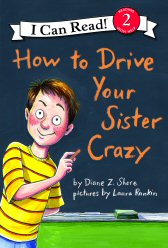|
How to Drive Your Sister Crazy
 How to Drive Your Sister Crazy How to Drive Your Sister Crazy
[Get this book on Amazon.com]
Warning! DO NOT try this at home!
Do you have a sister? Do you know how to drive her crazy? It's easy. Really easy. Take it from me, Bradley Harris Pinkerton. I'm good at it. Just ask my sister, Abby. NOTE: It's your job to drive your sister crazy. You might as well do it right.
If you're looking for the perfect prank to pull on your sister, Bradley Harris Pinkerton is here to help. Bradley's not-so-innocent instruction guide, complete with flying teddy bears, Slimey, the rubber snake, and ringing underpants, will have your sister screaming, steaming, and chasing you around the house.
NOTE: Girls, if you have a little brother, you'd better read this first.
The Story Behind the Story:
How How to Drive Your Sister Crazy! Became a Book
When it came time to teach my son, Sam, to read, he wanted nothing to do with it. "Mommies read. You read to me," was his answer. (I think he just assumed I would always be around to read, since the house next door was for sale, and he was planning on moving in when he grew up.)
And it was true, I read a lot to him, and I told him lots of stories. He enjoyed all the different picture books; we both did, but he loved to hear stories, especially the ones I made up about a boy named Sam who tormented his older sister.
At this same time I was about four years and totally committed to a career in children's writing. (It was either that or go back into auditing, and I figured writing stories for children would be more fun than writing audit reports. You think? And besides, how hard could it be to write a picture book? They're 32 pages and for 4-8 year olds!)
So, I had several picture book manuscripts circulating, as well as magazine pieces. I also entered writing contests, and the Children's Writer's newsletter was holding a contest for a beginning reader - a 500 word, how-to story, written in a creative way on how to do or make something. I knew they were looking for a craft or a recipe, as that was suggested in the rules, but I'm not handy with popsicles - I can make a cross- and "homemade" to me means "remove outer covering, heat one minute, and stir." But I'm always up for a challenge, so I turned on my computer, clicked "blank document" and sat down to write. Three hours later and the high score in Solitaire, I still had a blank document.
"This is a waste of time," I thought.
So, I switched to Hearts. Just when I was about to shoot the moon, my then 9 year old daughter came running into the room, with Sam close behind. "Tell him to stop!" she cried, then went on a five minute tirade of his latest peccadillos.
I sighed in frustration not only because this was a typical scenario in our house, but because I'd missed my turn in Hearts.
"Solve it yourself," I snarled. "I'm working."
"But he's driving me crazy and won't stop," she whined.
"He's the expert," I told her then, thought to myself he could write a book about it. And the light bulb flashed.
So I exited out of Hearts, gave Sam a big kiss for giving me the idea, and duct taped them both to the tree (one where I could keep an eye on them, of course), and started writing down those stories I had been telling Sam about the boy who tormented his sister. I wrote them as if the little brother were telling the reader how to do it. Then I ran it by my critique group, polished it up and missed the contest deadline!
Not one to put a good story to waste, I researched all the publishers that accepted beginning readers and came up with quite a long list. Now, I knew that HarperCollins not only had the best reputation, but also had the best beginning readers, but at this point in my career I wasn't that confident in my writing, so I settled for Random House's Step-Into-Reading. They rejected it, saying it didn't fit into any of their formats.
OK, why not go for the gold? So, I spent one afternoon at Borders and read every single An-I-Can-Read, counting the words, and making a graph of words per page and total words per book. (There was no way they were going to reject me on format!) Then I spent the next few days revising the manuscript into an acceptable An-I-Can-Read format, and sent it to HarperCollins. Months later, I got the manuscript back along with a letter from editor Anne Hoppe, who rejected it saying that it didn't fit into any of the I-Can-Read formats (WHAT!!?) ... BUT she did ask if I would be willing to write another chapter.
YES! And Heck Yes! I spent another two months revising, and came up with a pattern that I hoped would fit. And it did. Anne said yes and made an offer!
| 
